Turquino Plan: Development program founded by the Cuban Council of State on June 2, 1987 with the purpose of achieving an integral and sustainable development of the mountainous and difficult access areas of the country, harmoniously combining productive requirements with social development, nature conservation, and the strengthening of the country’s defense, and integrating in its actions the organizations and institutions involved in this process.
The mountainous areas of Cuba constitute 18% of the country’s surface, with a total of 678,207 inhabitants, equivalent to 6% of the total population, a population with a stable tendency and a small decrease in specific periods, according to specialized calculations by the National Statistics Office (ONE).
Geographically, it is divided into 4 mountain massifs: Guaniguanico, in the province of Pinar del Río; Guamuhaya, in the provinces of Villa Clara, Cienfuegos and Sancti Spíritus (former Escambray region); Sierra Maestra, which includes the provinces of Granma, Santiago de Cuba and Guantánamo; and the Nipe-Sagua-Baracoa Massif, in the provinces of Holguín (Sierra Cristal) and Guantánamo. Covering a total of 49 municipalities in 8 provinces. It includes 977 population settlements. Its population density is approximately 77 inhabitants per square kilometer (unequally distributed).
The Mountain Integral Development Program of the Turquino Plan includes not only 18% of the mountainous area of the country, but also an area that due to its geographical characteristics, historical background and as a strategic objective for the defense of the country, has been included, such is the case of the municipality of Ciénaga de Zapata in the province of Matanzas. Thus, there are 9 provinces with this Plan (Pinar del Río, Matanzas, Villa Clara, Cienfuegos, Sancti Spíritus, Holguín, Granma, Santiago de Cuba and Guantánamo), comprising 50 municipalities, some of them totally and others partially. At present, the Turquino Plan benefits about 700 thousand people distributed in the territories of the 10 Cuban provinces with mountainous relief.
In 1991, a new scientific-technical program called Integral Development of the Mountains was structured, led by more than 29 scientific institutions, in which results related to productive activities, mainly coffee, cocoa, forestry and other areas linked to food production, are carried out.
The economic productive development in these areas, as in the rest of the country, was very depressed in the 90’s due to the economic crisis of the special period, but in the last few years the production of food, viands and vegetables has improved, establishing in 2000 the highest production in the history of the Turquino Plan, and there has also been a growing trend in the production of pork, poultry, aquaculture and goat sheep.
At the beginning, the Plan had 1,966 primary schools, 83 secondary schools and 19 children’s circles. At present, the number of primary schools has doubled, the number of basic secondary schools has increased by 8 and the number of children’s circles has increased by 9.
Education is guaranteed to more than 150,000 students per year through a network of more than 2,300 centers of different types and levels of education, closing the cycle from the children’s circle and primary school (many of them provide services to a small number of students) to the Polytechnic Institutes and University Faculties of studies linked to the fundamental economic activity, agriculture and livestock.
The non-formal care system covers 99% of the population from 0 to 5 years of age, and 100% schooling is achieved for children from 6 to 11 years of age.
It has a low infant mortality rate, more than 100 medical offices, polyclinics with intensive care wards, centers for the development of Natural and Traditional Medicine, community pharmacies.
In health, there are a large number of facilities dedicated to guarantee medical and social assistance, among them, those that have suffered few variations from the quantitative point of view, but from the qualitative point of view, specifically due to the introduction in these areas of the Family Doctor and Nurse Plan, such is the case of the rural hospitals and polyclinics, which in their beginnings were responsible together with the Rural Medical Posts for guaranteeing medical coverage.
100% of the mountain population is covered by the Family Doctor and Nurse Practitioner Program. The PHC network has more than 1,000 clinics (more than 900 typical). There are more than 200 community pharmacies. More than 1,900 physicians are reported, most of them Family Physicians, the rest specialists of General Comprehensive Medicine, and physicians of basic specialties such as internal medicine, gynecology-obstetrics and pediatrics.

